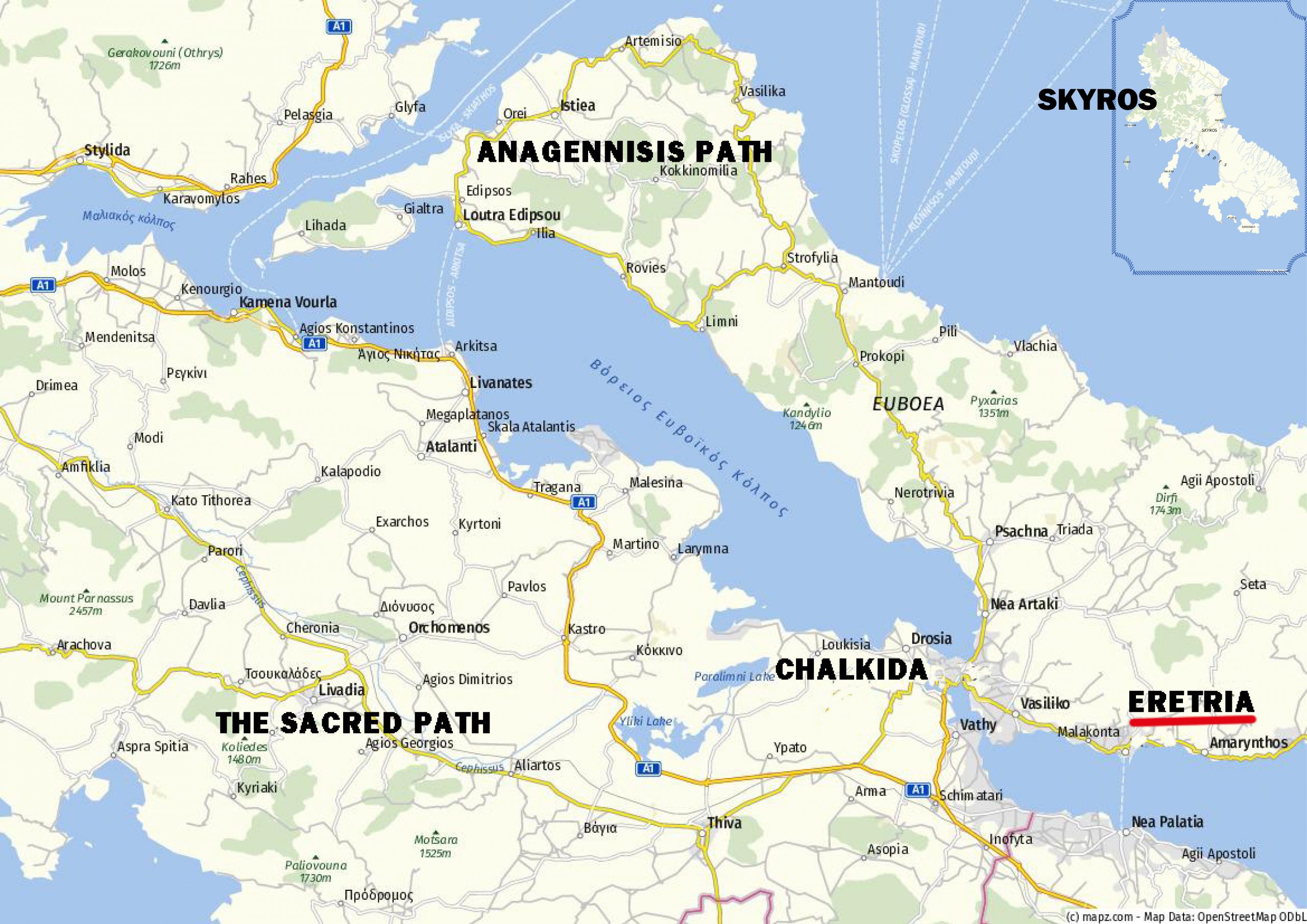ERETRIA “The path of Apostolos and Paramoni”
Destination
Attractions
Sustainability
How to get here
Accommodation
Food
Impressions
Others
Links
Destination
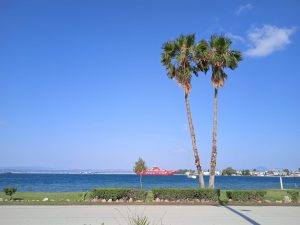 On the island of Evia southwest of Chalkida and opposite of Oropos coasts in Attica, is situated the beautiful coastal town of Eretria. Its name comes from the verb “eretto”, which means rowing, in the Ancient Greek language. Eretria was a great naval and commercial power of Greece, by the 8th century b.c. It already had many colonies on the Aegean coast, in southern Italy and in Crimea.
On the island of Evia southwest of Chalkida and opposite of Oropos coasts in Attica, is situated the beautiful coastal town of Eretria. Its name comes from the verb “eretto”, which means rowing, in the Ancient Greek language. Eretria was a great naval and commercial power of Greece, by the 8th century b.c. It already had many colonies on the Aegean coast, in southern Italy and in Crimea.
Attractions
Eretria is a popular destination for all seasons. It is close to Athens and it is an ideal destination for nature-lovers, cultural and alternative tourism and wine tourism. It also combines a variety of activities, such as water sports (sailing, water skiing, kite surf), horseback riding, mountain climbing and swimming in the beautiful sea. The area is also suitable for cycling.
The “Pezonisi” of Eretria, also known as the “Island of Dreams”, is a very small island that one can go from Eretria on foot. It is near to the port and its beaches are suitable for swimming.
In Eretria, tourists can visit olive groves and olive mills and see up close the olive harvest and the oil production process.
The visitors can also follow the “paths of vineyards”, where they can be guided to the vineyards and wineries of the area, learning useful information about the cultivation of vines and the varieties of wines.
Mount Olympus of Evia is very close to Eretria. It has a height of 1,172 meters and its vegetation consists mainly of firs and pines. Visitors can walk through the forest and admire the nature and the wonderful view.
Every summer, around the middle of July, a multi-day celebration named “Kanaria” takes place in Eretria, inspired by the fighter of the Greek revolution of 1821 Konstantinos Kanaris. The celebration includes dances, theatrical performances, musical events, painting exhibitions. Ιt is considered as the top cultural event of the summer in Eretria.
At the same time, the students of Eretria Junior High School, having actively participated in the implementation of cultural programs since 2014, such as the program of the NGO “DIAZOMA” “Students Guide Students to the Ancient Theaters”, conduct guided tours of the Ancient theater, for students of other schools who visiting the area.
It is a wonderful experience to visit the Archaeological Museum of Eretria. The museum of Eretria has been operating since 1991 and presents the history of the city from prehistoric times to Roman times. One of the most famous exhibits of the museum is the small clay Centaur, found in the cemetery of Lefkanti and is the oldest representation of this mythical creature.
Inspired by the program “Smart travelling around Europe: A Youth Guide for Sustainable Tourism”, the students of Eretria Junior High School mapped out two routes of cultural interest in the city of Eretria and made up two stories, introducing two fictional protagonists “Apostolos” and “Paramoni”, in order to highlight the cultural feature of each route.
“The route of the Apostolos” refers to the refugee settlement of the city of Eretria, where Greeks who lived in Prigiponnissa (islands opposite Constantinople) were exiled from their homeland in 1922 and settled in Eretria, making a new beginning. The architecture of the houses, the traditional music, the traditional dances and the traditional cuisine of minor Asia travel visitors to other eras. Through the narration of the Greek refugee Apostolos, visitors learn how to turn the difficulties of life into opportunities for creation and rebirth. The journey ends at “Panagia Paravouniotissa”, an orthodox church where the Byzantine icon of “Panagia Paravouniotissa” was brought there by the Greek refugees from Prigiponissa in 1922.
The Cultural Route of “Paramoni” integrates the archeological findings that are scattered around the city (Ancient port of Eretria, Roman baths, house with mosaics, ancient Theater). Thus, visitors have the chance to come in contact with Ancient Eretria, the daily habits of the inhabitants and the trade relations that the Eretrians had in ancient times, with the other people around the Mediterranean sea, such as the Egyptians.
Sustainability
During the summer period on the coastal road of Eretria, the traffic of cars is prohibited and only the pedestrians, bicycles and electric scooter is allowed. All over the year, people can visit local farms and participate in workshops that include activities in nature, such as cultivation and harvesting of fruits, vegetables and olives.
At the same time, the participation of the inhabitants in celebrations and the revival of customs and historical events in Eretria, where the past and the present exist in harmony, proves that the historical monuments that anyone can see everywhere in the town, are not just tourist attractions but a living part of resident’s everyday life.
The visitors of Eretria should not miss to visit a sea area of special environmental interest: The valuable «Meadows of Posidonia» in the sea area of Eretria. The sea area of Eretria is full of Posidonia oceanic meadows, the so-called “sea forests”.
Posidonia is a plant of the Mediterranean Sea and is protected by law. “Meadows of Posidonia” cover an underwater sea area where many sea animals live, nest, feed and breed, such as fish, seahorses, mollusks, sea turtles and others as well as algae. The meadows of Posidonia produce large amounts of Oxygen, as well as the Tropical Forests! And they bind significant amounts of Carbon Dioxide CO2. That is, they are an important defense “weapon” of nature and life on Earth against climate change.
Just as terrestrial plants hold the soil to the ground with their roots, so the forests of Posidonia hold the sand in the sea with their roots! Posidonia with its volume functions as a natural “breakwater” reducing the momentum of the waves! The waves would cause great erosion on the coast, if the Posidonia Forests didn’t exist.
One square meter of Posidonia Forest is equivalent to about twenty square meters of sand on the coast! That is, when someone destroys even one square meter of Posidonia in the sea, he is responsible for twenty square meters of sand, which will be lost by the momentum of the waves!
Today, Posidonia is threatened by human interventions, such as fishing with sliding gear, mooring, fish farming, and technical projects taking place by the sea. The sea worldwide, is overfished. The creation of protected areas will result in the return of lost biodiversity in the sea. It could also turn Eretria into a center of Ecological-Diving Tourism, paving the way for new green professions related to diving observation, and marine photography.
How to get here
From Athens to Eretria by Car via Chalkida
Starting from Athens, follow the National Road Athens – Lamia, after Schimatari, turn right in the direction of Chalkida. You cross the High Bridge of Chalkida and at the junction you meet turn right in the direction of South Evia. You reach after 3km in Lampsakos town and then continue straight, you pass the town of Vasiliko and continue straight, at 11km you reach the entrance of Eretria where you turn right. The route from Athens to Eretria via Chalkida is 95 km.
From Athens by Car via Ferry Boat (Oropos – Eretria)
From Athens after the first toll of National Road of Athens – Lamia and at 1km, at Malakasa, turn right with direction to Oropos. After 10km you reach the port of Oropos. It is worth mentioning that the routes from Oropos to Eretria and vice versa are very frequent * (every 30 minutes) while the duration of the sea voyage does not exceed 30 minutes duration. According to the absolute mileage value, the route from Athens via Oropos is 50 km.
* Itineraries may change during the winter.
From Athens to Eretria by bus (KTEL)
You can use the bus line from Athens to Eretria. The bus station is located in 260 Liosion Street – Athens (Liosion Bus Station). Daily itineraries from Athens to Eretria are available. You can find more information here:
Accommodation
Negroponte Resort Eretria
Negroponte Resort Eretria is located on Evia Island, 2,5km from the city of Eretria and 19km from the city of Chalkida. Negroponte was the Venetian name of Chalkida. https://negroponteresort.gr/
Miramare Hotel Eretria
Miramare Hotel spreads in an area of 22.000 square metres of gardens, surrounded by Mediterranean vegetation of mature olive, mandarin, lemon, orange, fig and almond trees. https://www.miramare-eretria.gr/
Sunrise Hotel Eretria
Hotel Sunrise is situated near the center of the city of Eretria. In the middle of a total green landscape, hotel Sunrise offers you a big swimming pool with a pool bar. Only 150 meters away from the nearest beach.
Milos Camping Eretria
In an evergreen private area of 18.000 square meters, precisely in front of the spotless sea of Evian gulf, the Milos Camping has been a pioneer for many years placing his own specifications in the space of camping tourism.
Food
Eretria, is famous for its fish food and Mediterranean cuisine. On the beach, the visitors can find many restaurants and taste local dishes.
Impressions
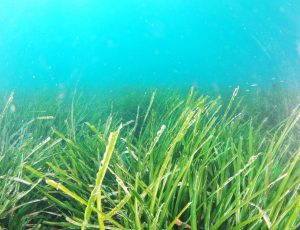
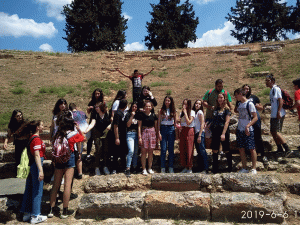
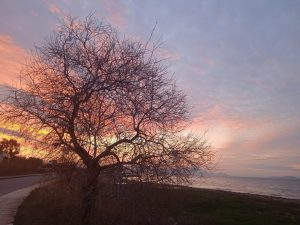
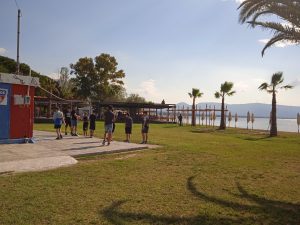
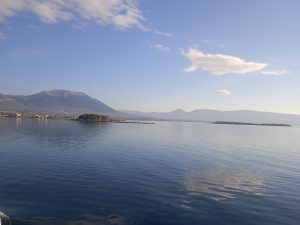
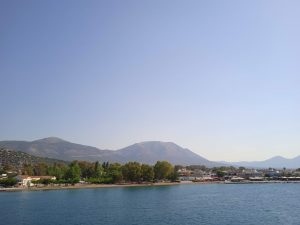

Others
“The path of Apostolos” – A little story.
Hi everyone,
My name is Apostolos, 4th generation Greek refugee from Ionia. My great grandparents came to Eretria in 1922 when the Asia Minor disaster happened.
My neighborhood is one of the 2 settlements that was given back then to the Galimites, to those who came from the Galimi village of Marmaras.
Back then, it had swamps but nowadays it is one of the most beautiful areas of our city.
I have memories of the colorful gardens including jasmines, the smells of spices and cinnamon that spreads from the open windows of the houses, fishermen mending their fishnets from the one edge of the street till the other one, housewives singing and knitting, grandmas giving their tired from playing grandchildren a slice of wet bread with sugar, my special clothes for the church, Sunday’s rich dinner.
As a teenager, wandering by riding my bike, I sometimes stand at the start of neighborhood (machala) and remember…sometimes I laugh…others I get emotional…
Moving on, I stop at Grigoraki’s house, an old man that came when he was 3 years old from the lost homelands. I greet him, kiss his hand…taking his wish.
Then I get to the lighthouse. I like watching the fishing boats and passenger ships…I leave my mind travelling…
Other times, I go fishing there with my grandpa, I take photos with my friends, I walk with my loving one under the moonlight.
Continuing my walk, I feel proud of my ancestors which from poor fishermen became shipowners…became hoteliers and motel owners like the one that is in my neighborhood…became scientists and traders, businessmen and bakers, like Mrs Chrisoula who with her refugee buns honors the Virgin Mary the Paravouniotisa at the day that is dedicated to her.
Getting back home, I ask myself how I can be worthy of my ancestors…
Their music and songs, foods and sweets, dances and costumes put me into thoughts and ideas.
My secret desire is to be as innovative as them, be loyal to the traditions and create…
My secret desire is to collect any kind of material and create a museum for the Asian’s Minor refugees of Eretria.
Links
ΕRETRIA
CULTURAL SUSTAINABILITY
VIDEO: PATHS OF CULTURE IN ERETRIA
https://vimeo.com/572209874
ENVIRONMENTAL SUSTAINABILITY
VIDEO – PRESENTATION BY Mrs. PANAGIOTA TSIRIMOKOU (TEACHER OF GERMAN LANGUAGE MSc IN ENVIRONMENTAL STUDIES): ERETRIA: «THE SEA MEADOWS OF POSIDONIA»
https://video.sch.gr/asset/detail/e2hIFGkmqCCaiPabYjjdKeJj/g2dTJ5fcJEZUnfJ8CXSj5qUH
Anagennisis path
Destination
Attractions
Sustainability
How to get here
Accommodation
Food
Impressions
Links
Destination
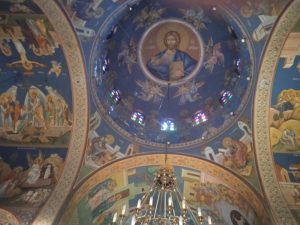 The path “Anagennisis”, concerns destinations of environmental and religious interest in North Evia. Specifically, we explore the areas of Edipsos Baths, Limni and Lichadonissia.
The path “Anagennisis”, concerns destinations of environmental and religious interest in North Evia. Specifically, we explore the areas of Edipsos Baths, Limni and Lichadonissia.
The area of North Evia was known for its forests and in general the rich vegetation that reached the sea. In August 2021, the catastrophic fires that hit North Evia left behind thousands of acres of burned forests. Many people lost their property and their jobs, especially those who worked in the agricultural sector. That’s why we symbolically named the path, ” Anagennisis”
We have defined the Baths of Edipsos, as the center of the path “Anagennisis”. The Baths of Edipsos are about three hours away from Athens.
Attractions
Why do we suggest North Evia as a travel destination?
There are many places that one can visit in North Evia. Let’s start our tour from the city of Edipsos.
Edipsos is the oldest Spa in the world and has over 80 thermal springs. During the Roman and Byzantine eras many emperors and generals, visited Edipsos for healing purposes. Today it is a tourist destination that is connected, not only with spa tourism but also with body and face treatments. The last few years, hot springs of the area are used not only for therapeutic purposes but also for wellness. If you want a refreshing and stressful destination Edipsos is the ideal choice as it has many Spa hotels and hydrotherapy centers. It is no coincidence that Winston Churchill, Greta Garbo, Aristotle Onassis and Maria Callas chose Edipsos for relaxation.
In Edipsos, you can admire the old hotels of Belle Époque architecture, as well as the cave of the Roman general Silla, who visited the Baths for therapeutic purposes.
If you want to learn about the forests of the area you can visit the forest museum in the village of Prokopi. But if you want to travel back in time, you must visit the museum of fossil mammals in the village of Kerasia.
If you are looking for moments of calm and peace, the monasteries of Saint David, St. Georgios and the temple of Saint Ioannis the Russian, are the ideal places with mystical atmosphere.
You should not miss a one-day trip to Lichadonissia, a cluster of seven small islands in the Northwest of Evia. The light blue waters of the sea and the beaches with golden sand will enchant you.
If you want to experience a lifestyle change, with the main purpose of love and respect for the environment, it is necessary to visit the autonomous eco-community Free And Real, the purpose of which is revealed by the initials of its name, (Freedom of Resources for Everyone, Everywhere & Respect , Equality, Awareness and Learning). This is a non-profit, non-governmental organization, a school of self-sufficiency, in the area of Agios of North Evia, where it implements the Telethrion Project, in the framework of which, through workshops and actions, shows us how to live with self-sufficiency and respect for the environment.
The Telaithrion project, is an eco-friendly world plan, built by multiple open minded people, with a dream to live in a self-sufficient sustainable society, which does little to no harm to our environment. The main goal they have in mind is to not only educate people on why our environment is crucial to us, but also, to show us that a world where selfless giving can truly exist if a lot of people put their body and soul to it. They want to build a healthy wavelength between environment, humans and technology by trying to prove to us that technology is nothing more than a tool to aid humans’ lives, and in order to achieve that, they came up with the “Telaithrion Project (pronounced ‘Te-le-thri-on’), which consists of ways to actively help our world.
Their dream, that has been put into action, develops around their ideas of building a ‘perfect’, small town, where no natural resources go to waste. By viewing the video on Telaithrion Project’s website, we can get an idea on what it’s all about. The plan consists of:
-Geodesic dome clusters
– Yurt modules
-Landscape bio-architectures
-Renewable energy sources
-Alternative research into plants and conservation
-A natural forest garden
-Microclimatic appliances
-Permaculture designs.
By following this plan, Telaithrion promises a healthy environment, and also hopes to convince everyone, that the perfect society can really exists.
If you want to have an experience of Aegean architecture, then you must visit the village of «Limni». if you visit the folklore museum of Limni ,you will be fascinated by the beauty and the rich history of the place. Moreover, is extremely interesting the collection of exhibits of Professor Christomanos. You can visit the Hydrobiology Museum in Limni and see his collection. He made this collection from his research voyages with Jacques Yves Kousto .
If you want to do some sports during the holidays, you can do water sports on the beaches of the area, horse riding and cycling.
For cinema lovers, from June 15th to 19th, the Evia film Project starts in Evia. For the needs of the Film festival, cinemas that were closed for many years have been renovated and reopened. In the context of the Festival are organised daily discussions and masterclasses, on the exclusive topic of the environment. Sustainability, and good practices related to this topic, are presented too in order to promote an environmentally friendly lifestyle. For few days, North Evia becomes an international center of Green cinema.
Sustainability
The region of North Evia is related to cultural and environmental sustainability. The hot springs located in the area have been used since antiquity for bath therapy and continue to be a core of the local economy until today.
Over the years and due to the increase in tourist traffic, spa tourism has evolved into wellness tourism resulting in the creation of new modern hotel units and the evolution of existing ones, offering wellness and rejuvenation services. This resulted in the emergence of new professional specialties in the area such as beauticians, dermatologists, physiotherapists, chiropractors, ecotherapists, etc.
Finally, the monasteries that exist in the area with their rich history, attract many visitors from around the world. The monasteries are strongly related to many traditions and customs of the area.
Finally, the Evia film festival organized in North Evia, gave the opportunity to reopen cinemas that did not operate for many years. The Evia film festival is included in the program “Fotodotes” of the NGO “Diazoma”, which has as its main goal the reconstruction of North Evia (after the deadly fire of August 2021). The “Fotodotes” program is based on the pillars of the European strategy (Green, Smart, place-based) and aims at energy autonomy, environmental regeneration in new forms of agriculture and gastronomy and new forms of entrepreneurship focusing on the green economy and innovation.
In the following link, you can watch the presentation of Ms. Bellogianni, head of educational programs of NGO “Diazoma” in the framework of the Erasmus+ program. https://video.sch.gr/asset/detail/I1jFTKiaiOTg5mkeGe8ltv8J/
How to get here
North Evia is an affordable destination, both from Athens and Thessaloniki. If you are coming from Athens, after 150 km., on the Athens-Lamia National Road, you will reach the port of Arkitsa. Then, board on the Ferry Boat and after 45 minutes you will reach the port of Edipsos. More information you can find at the following link:
https://www.ferriesedipsos.gr/timetable-edipsos-ferries.php
If you are coming from Thessaloniki, follow the National Road Thessaloniki-Lamia and then follow the exit to Glyfa. At the port of Glyfa, you will board on the Ferry boat to Agiokampos in North Evia. The trip takes about 30’.
See the following link for information on ferry services:
https://www.ferriesglyfa.gr/timetable-glyfa-ferries.php
If you choose to travel to North Evia through the city of Chalkida, the distance from Chalkida to the Baths of Edipsos is about three hours. The route is very beautiful, and you have the opportunity to get to know other natural beauties of the island of Evia.
There are daily services from the Bus station in Athens to Edipsos and other areas in North Evia.
For more information check out the following link:
https://eviaportal.gr/evia-plirofories/dromologia-yperastikon-leoforeion-evoias/
Accommodation
In North Evia you have several accommodation options, we indicatively mention:
In the Baths of Edipsos:
https://www.thermaesylla.gr/el/
https://www.almyra-holiday-village.gr
https://www.anesishotelspa.gr/
http://avraspahotel.gr/avraspa/index.php
For camping lovers:
Food
North Evia is famous for its famous seafood, however do not forget to try royal jelly, as well as green olives from Rovies village, that have been awarded abroad, for their quality and taste.
The area of Northern Evia is also known for its traditional sweets. One of them is the sweet “kourabiedes”, made from pure butter, flour, almonds and sugar. Also, the donuts garnished with honey, cinnamon and walnuts are delicious!
Finally, pine or thyme honey, and the handmade traditional pasta, such as noodles and trachanas, made N. Evia an important gastronomic. It is worth trying these products, as it is another reason that makes Northern Evia unforgettable!!
Impressions
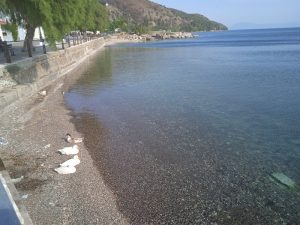
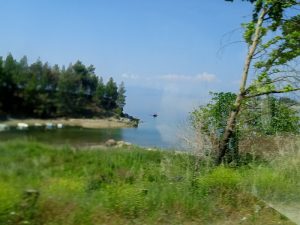
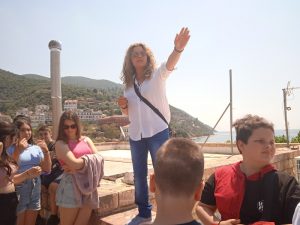
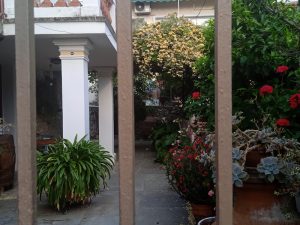
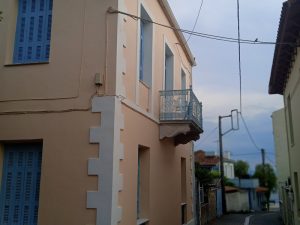

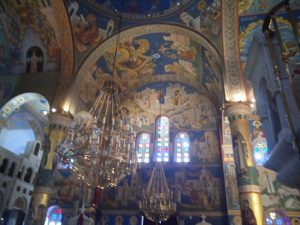
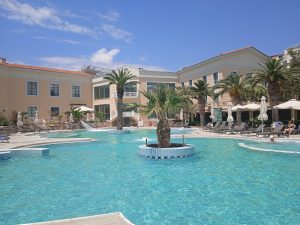

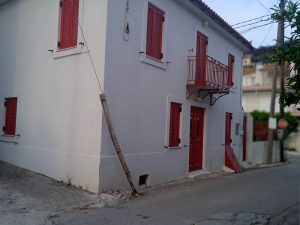
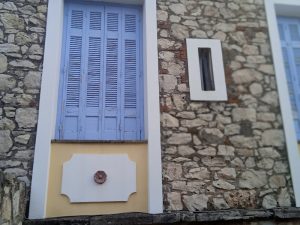
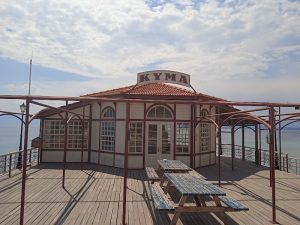
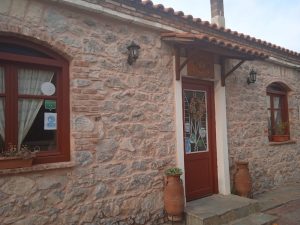
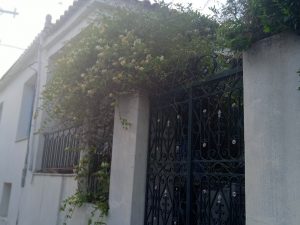
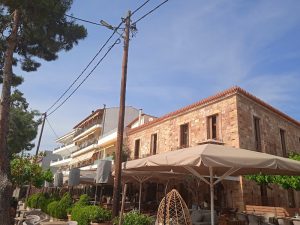
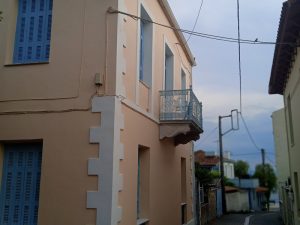
Links
EDIPSOS – NORTHERN EVIA
CULTURAL AND ENVIRONMENTAL SUSTAINABILITY
PRESENTATION «THE ANAGENNISIS PATH» NORTHERN EVIA
https://view.genial.ly/6270186186de020018f4c0de/guide-vibrant-travel-guide
VIDEO PRESENTATION BY Mrs. MARY BELOGIANNI, ABOUT THE HOLISTIC PROGRAM FOR THE RECONSTRUCTION AND SUSTAINABILITY OF NORTHERN EVIA.
https://video.sch.gr/asset/detail/I1jFTKiaiOTg5mkeGe8ltv8J/
THE PATH OF AROMAS AND COLORS
Destination
Attractions
Sustainability
How to get here
Accommodation
Food
Impressions
Others
Destination
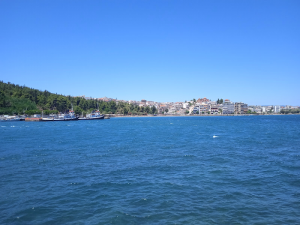 Chalkida is the capital of Evia, the second largest island of Greece. The blue color of the sea, the taverns and cafes on the beach road of Chalkida contrast with the imposing picturesque green scenery of the village of Steni. Steni is located on the southern slopes of Mount Dirfys, in pine and chestnut forests. In winter, about a meter of snow falls in the area, creating an idyllic winter landscape. In spring and summer, you will be spellbound by the aromas of the herbs that grow in the area. That is why we gave this name to the path, “‘THE PATH OF AROMAS AND COLORS”.
Chalkida is the capital of Evia, the second largest island of Greece. The blue color of the sea, the taverns and cafes on the beach road of Chalkida contrast with the imposing picturesque green scenery of the village of Steni. Steni is located on the southern slopes of Mount Dirfys, in pine and chestnut forests. In winter, about a meter of snow falls in the area, creating an idyllic winter landscape. In spring and summer, you will be spellbound by the aromas of the herbs that grow in the area. That is why we gave this name to the path, “‘THE PATH OF AROMAS AND COLORS”.
The city of Chalkida is only 80km away from Athens. Because of its geographic position the city has a great history and remained a crossroad of ideas and culture, over the centuries. Today, Chalkida is the commercial center of the island, built on both sides of Evripos bridge. It is an ideal destination for short breaks, especially for the people who live in Athens, and everyone could have easy and quick access to the city thanks to its modern cable bridge.
Half an hour away from Chalkida-following the route of Artaki village you reach the beautiful village of Steni. Steni village is in the outskirts of Dirfis mountain the highest mountain of the Evia Island. The village it is known for its rich nature, its springs and delicious food. Although Steni is famous for its dense snow fall during the winter season, it is an interesting destination for all seasons of the year.
Attractions
Through the historical monuments of Chalkida you travel back in time.
Our first stop is the medieval basilica of Agia Paraskevi which stands at the center of the Castro district in Chalkida.It was built in the byzantine times and was reconstructed by venetians. The interior of the temple reveals the collaboration between French, Italian and Greek artists.
We continue our tour to the archaeological museum of Arethousa which is hosted in the old spirit factory of the early 20th century called Arethousa.
The exhibit of the museum reflects the religious, economical and cultural identity of Evia and Skyros island, from the prehistoric era until the establishment of the Greek modern state.
Our next stop is the fortress of Karababa Sultan, who gave his name to the castle, as he was buried in it. The Ottomans built this castle in 1684.Nowdays, Karababa castle become a museum into where Arabic funerary dedications and inscriptions, shows us its interesting history.
A walk by the Evripos bridge in Chalkida will relax you and give you the opportunity to admire the architecture of the buildings near the seaside. One of them is the famous «Red house». The «Red House» of the Mallios family is located on the north side of the beach in Chalkida. It was built in 1884 by the French architect Fleggis. It belongs to the Municipality of Chalkida. Nowadays, «The Red House» is used for cultural events.
We continue our cultural journey, through the Biomechanical Festival (organized every summer by the Theater team of Chalkida in Avlida, a town near Chalkida). Many theatrical performances are presented there, as well as musical events, with artists from all over the world. Of particular interest is the place where the festival takes place, the old quarry in the area «Vathi» of Avlida, which has been abandoned for years and nowdays has been transformed into a place of artistic expression and creation.
Chalkida offers many activities to its visitors, such as water sports, beach volley, mountain climbing, horse riding and hiking in the countryside. You can also swim in its crystal clear beaches such as Kourendi beach, St. Minas, Souvala and the famous beach of Alykes just 7 Km. away from Chalkida.
Chalkida is also Known as the city of «creasy waters», because of a unicque phenomenon, the swift change direction of sea waters, every six hours. During each change of direction, the water stops moving for about seven minutes. It is interesting to observe this phenomenon.
The famous Greek writer Giannis Skaribas wrote for the city of Chalkida, (his homeland) «The roads are broken, the south wind is blowing and me all alone saying: What a city»!
Half an hour away from Chalkida, following the route through Artaki village, you will reach the beautiful village of Steni. The springs of the gurgling water coming down from the mountain and the rich vegetation compose a beautiful scenery.
The chapel of Saint Kiriaki in Kambia village near Steni will impress you as the interior of the temple rests in a rock and the scenery creates a mysterious atmosphere.
Another sight you should visit, is the Aesthetic Forest of Steni, which is one of the nineteen aesthetics forest in Greece and it comes under the heading of the European ecological network “Natura”. The forest covers an area of 500 hectares and attracts nature are lovers from all over the world. It is ideal place for climbing , mountaineering, walking and hiking. Moreover, you can take part to the Dirfis Marathon road race that takes place in spring.
Do not miss to visit “Agali” gorge. The path is walkable even by small children.
If you are interested in exploring the varieties of mushrooms and herbs, you can attend masterclasses from experts, in the nature of the mountain Dirfis, which is full of herbs and mushrooms.
Sustainability
«The path of aromas and colors» is related to cultural and environmental sustainability. The reuse of old industrial buildings in Chalkida, such as the archaeological museum “Arethoussa” housed in the old spirit factory with the same name , the “Red House” of the Malliou family, which is now used as a place for art and cultural events, the old quarry in Vathi- Avlida where it has been transformed into a place for art and culture, by hosting the Biomechanical festival every summer, but also the monuments that exist in the city and still reveal its history, have established the city of Chalkida as a tourist destination of cultural interest.
In the village of Steni, the continuation of traditional arts such as wood carving and weaving by the locals, the harvesting and trade of medicinal plants and mushrooms, as well as the rich vegetation of the area make the place of Steni and mountain Dirfis a tourist destination of cultural and environmental interest, for all seasons of the year.
How to get here
ATHENS TO CHALKIDA, TRANSPORTATION
CHALKIDA TO STENI- TRANSPORTATION
Dirfis mountain is a famous for its heavy snowfalls in winter, as the snow usually reaches the 1 meter inside the village of Steni. That’s why in the winter season you should be informed about the weather before you go there.
https://www.ktelevias.gr/gr/routes
Accommodation
CHALKIDA
https://www.facebook.com/HotelPaliria/
http://almiramare.gr/el/front-page/
STENI
https://www.facebook.com/mousiko.pandoxeio.steni/
https://www.facebook.com/vasilikiguesthouse/
https://www.facebook.com/HotelSteni/
Food
In Chalkida you will find many taverns all around the city and in the seaside . There are also restaurants serving Mediterranean and international dishes, as well as restaurants for vegetarians. However, Chalkida is famous for its seafood and fresh fish. In Steni village you will enjoy delicious meals with appetizers, grilled meat, baked potatoes, green salads, delicious cheese pies, grilled local cheese, steaks and grilled mushrooms. You can taste these meals in the taverns and traditional restaurants in the central square of the village.
Impressions
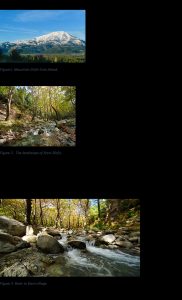
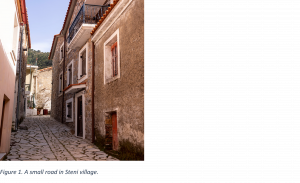
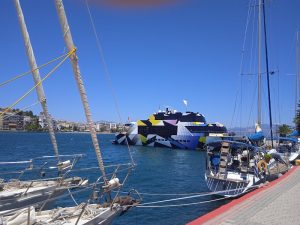

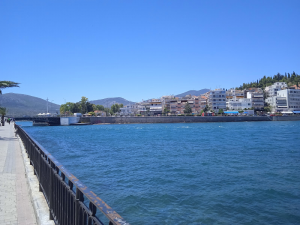
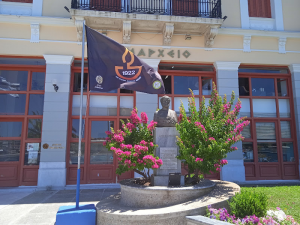
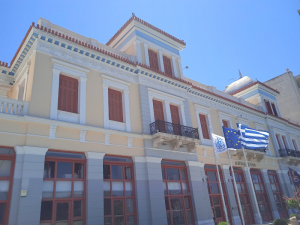
Others
“Karidokourambiedes” a traditional sweet from Chalkida.
Materials
300 gr. powdered sugar
1 teaspoon of baking powder
1tea-cup of butter
1 coffee-cup of ouzo
3 vanilla pods
1 egg
1 kg of flour for all purposes
1 glass of roasted walnuts
A little powdered sugar for sprinkling
Beat the butter in the mixer and slowly add the sugar.
Add the rest of the ingredients and knead. We create
different designs and place them in a buttered pan.
Bake the walnut kourampiedes for about 20 minutes in
250 degrees Celsius. When they are baked, sprinkle them with sugar.
“The Sacred Path”
Destination
Attractions
Sustainability
How to get here
Accommodation
Food
Impressions
Others
Destination
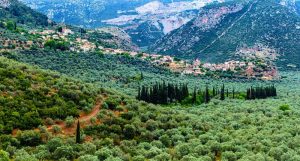 The sacred path consists of nearby destinations in the region of Boeotia. It includes the monastery of Osios Loukas, the Sanctuary of Delphi, the city of Amfissa with its famous olive groves and the area of Arachova.
The sacred path consists of nearby destinations in the region of Boeotia. It includes the monastery of Osios Loukas, the Sanctuary of Delphi, the city of Amfissa with its famous olive groves and the area of Arachova.
The monastery of Osios Loukas is located at the foot of mountain Elikon in Boeotia. Osios Loukas Steriotis, who was known for his love for animals, nature and his healing gift, lived in this monastery. It is a 1000-year-old monastery and since 1999 it is a UNESCO World Heritage Site. It was ruled by Latin monks during the years of Franciscan rule and during the years of Ottoman rule it passed into the hands of the Greek monks, playing an important role in the revolution of 1821.
The architecture of the monastery complex and its wonderful mosaic creations have made the monastery known all over the world.
Almost 20 kilometers further at the slopes of Mount Parnassos is the Holy Oracle of Delphi, the most famous oracle in Greece.
The sanctuary of Delphi in ancient times was considered “The navel of the Earth” as according to mythology the two eagles that had been sent by Zeus to find the center of the world, were met there. His oracles, which were considered the most reliable, were expressed by Pythia, priestess of the oracle, and were interpreted by the priests of Apollo. Cities, rulers and ordinary people hurried to consult the god and expressed their gratitude with brilliant votive offerings, which gradually flooded the sanctuary. It is believed that the Delphic oracle made decisive predictions about the flood of Deucalion, the Argonaut expedition and the Trojan War, while the important role of its opinion in the establishment of the Greek colonies is confirmed.
In modern times, the Delphi area was associated with the effort to revive the Delphic idea, by the poet Angelos Sikelianos and his wife Eva, who presented two performances of ancient drama, in 1927 and 1930, wanting to create a new spiritual place.
At a distance of about 18km from Delphi, between the mountains of Parnassos and Giona, is the beautiful city of Amfissa, which is the capital of Fokida and keeps its identity unchanged. An important feature of the area is its Olive grove, one of the largest in the world and protected by the Natura 2000 network.
Thirty minutes from Amfissa is the cosmopolitan Arachova.
Arachova is a small town, built on the southern slopes of mount Parnassos at an altitude of 950 meters. Arachova is famous for her winter sports on mountain Parnassos. Modern Arachova, despite its rapid growth, maintains its traditional character, its customs and traditions.
Attractions
On this route there are many attractions that one can see.
Starting from the monastery of Osios Loukas, travelers can visit the monastery buildings, discuss with the monks and get to know the way of their life. They can also admire the famous mosaics inside the church and the wonderful view of the slopes of Elikonas.
In an atmosphere of calm and fullness, the journey to the Holy Oracle of Delphi, where history is combined with mythology continues. The tour of Castalia spring, where its water was used for the purification of priests and believers, the Sanctuary of Apollo, the Ancient Theater and the Stadium, travel us to the mysterious atmosphere of the past. The tour is completed by a visit to the Archaeological Museum of Delphi to admire its rich collections that include statues, tributes etc.
We continue our tour in the city of Amfissa where photography lovers can start with a walk in the city to see and take photos of the beautiful old mansions.
Then we visit the historic castle of Salona. The castle has a great history that starts from the Pelasgians and classical antiquity and reaches the Greek Revolution.
Over the centuries the castle was destroyed, rebuilt, conquered by Philip II, the Gauls, the Romans, the Bulgarians, the Slavs, the Franks, the Catalans and the Ottomans.
Fans of the art of painting can visit the Metropolitan Church of the Annunciation and the Municipal Gallery “Spyros Papaloukas”, to see up close the drawings made by the great painter, for the Metropolitan Church, known as “Anthivola” .
Lovers of climbing are worth visiting the climbing field of Amfissa in the area of Saint Konstantinos that include up to 29 Sport routes, up to 25 meters high, suitable even for beginners.
Do not miss to visit the traditional district of Harmaina. It is definitely the most picturesque district of Amfissa! In the past, tanneries were known as Taipakaria. The atmosphere that is “hidden” between them will enchant you by wandering in the stone alleys! Also, the famous Harmaina Carnival is an experience that should not be missed.
The Amfissa Olive grove is the largest in the country and belongs to the famous Delphic Landscape. It is estimated that it consists of more than 1,200,000 olive trees, some of which exceed five meters in height, while their age is lost in the depths of the centuries.
According to historical data, the olive trees of Eleonas of Amfissa exist since the Neolithic Age! The Pelasgians were the first, according to the sources, however, to plant olives here in prehistoric times. From then until today, the use of space has never changed, no matter how many conquerors have passed.
If you are here in autumn or winter, you will also watch the picking of the fruit in the traditional way, which has lasted since antiquity.
The Olive grove of Amfissa is characterized as traditional and is protected by special provisions.
If you want to follow the lives of miners and visit a real underground gallery, then visit Vagonetto Fokis Mining Park. It is a unique thematic park, where you will have the opportunity to follow the lives of bauxite miners through their narrations and visit a real underground gallery.
Fans of theater and historical atmospheric cafes, should definitely visit the “Grand Café 1929” which has been operating since 1929 and is a member of the International Cultural Organization “Road of Historical Cafes”. At that time it was called “Panellinion”. This is the only Cafe in Greece with a theatrical stage. It flourished during the interwar years and later hosted theatrical performances of the time. It is worth noting that this Historical Cafe was chosen by the great Greek director Theodoros Angelopoulos for the shooting of the film “Troupe”, which is one of the 10 best films of all time! The “Big Cafe 1929” has offered a lot to the culture of the country as it supported the theater. Today, it has been renovated in the colors and style of the interwar period that characterizes it so much.
At the same time in the area of Arachova operates the Agricultural Craft Cooperative of Arachova, where the locals use natural raw materials and give lessons in weaving and gold embroidery to visitors as well as cooking with recipes based on local materials.
Arachova is famous for her winter sports on mountain Parnassos. Parnassos ski Center has 23 slopes and it is an alternative destination for mountain activities in Central Greece. An area in nature, just for hiking, mountain biking, mountaineering, exploring the places and many other different activities.
Last but not least ,as you walk in the square of Arachova you can find the “tea street” in which you will find many shops and cafes with many varieties of its famous tea.
Sustainability
The rationale for the design of the Sacred Path was based on the combination of two monuments that have been included in the list of UNESCO World Heritage Sites: The most important Byzantine monument of 11th century Greece, the Monastery of Saint Luke of Steriotis and the city of Delphi, where the most important oracle of the ancient Greek world was located, “The oracle of Delphi”
The use of natural materials such as stone and plaster for the construction of the church of Osios Loukas proves the absolute respect of craftsmen to the environment and nature. Also, the way of life of the Orthodox monks that was founded in the 4th AD. century and is based on equality, common ownership (all material goods belong to all) self-sufficiency of goods, respect and protection of the natural environment, the use of natural traditional forms of energy for the operation of the monastery, the sale to tourists of pure natural products produced in the monastery, make the way of life of the monks an example of sustainability that has its roots in the early Christian years. Through the monks way of living, the visitors of the monastery can adopt good practices of sustainability in their daily life.
The continuation of traditional techniques from generation to generation in art, such as weaving and embroidery, is one of the key elements of sustainability in the area. (The weaving art was widespread among the women of Arachova, who from an early age learned to create real art pieces. Over the years, however, this art began to disappear, until the women of the Arachova cooperatives took over their work. They give textile art lessons to young people living in the area and to visitors as well, who are interested in learning this traditional art.
In rural life, the traditional way of harvesting olives “the sticking” continues to this day by local producers. Many visitors have the opportunity to participate in the olive harvest learning the specific technique – which does not destroy the tree or its fruits – with the guidance of olive growers.
The traditional cuisine and the traditional production process of products such as “Formaela” cheese. Registered by the European Union with a designation of origin, “Formaela”, the Vlach cheese of Arachova is made from fresh sheep’s milk and is – roasted or fried – one of the most delicious products in the region.
Also, the preparation of pasta in the traditional handmade way from pure materials of the area that the women of the cooperatives of Arachova continue to this day and give lessons of pasta making and cooking to anyone interested in knowing the unique traditional recipes of the area.
The renovation of the traditional settlement of “Harmaina” in Amfissa is another example of the sustainability of the area. Since 1989, forty-two buildings of the old settlement have been declared protected. The renovation of the buildings and their reopening as places of art, catering and culture, creates a very nostalgic atmosphere that culminates with the revival of the legend of the “Stihio (ghost) of Harmaina” on the last Saturday of the Carnival period.
It is worth mentioning the renovation and reopening of the historic place “Big Cafe”, as well as the reopening of the “Stoa 850” of the old mines, but not for the purpose of bauxite mining, which had stopped twenty-five years ago, but for tourism and educational purposes, to highlight both the history of bauxite and to pay tribute to the miners of Fokida.
The activities of the European Cultural Center of Delphi (EPKED) which aims to create in Delphi a European and global spiritual center where events are held and personalities from the field of Art and culture are hosted, in parallel with the Delphic operation. Academy of European Studies is located at the same place, where seminars, masterclasses and artistic events are held with a focus on the humanities. A fact that attracts many visitors and students throughout the year.
Finally, in the area of Amfissa, many seminars and educational activities based on the natural environment and sustainability are held by the Amfissa Environmental Education Center.
How to get here
Accommodation
There are many hotels in the area of Delphi and Arachova. Indicatively we suggest:
Leto -Delphi Hotel
Located in Delphi, it offers services with respect for the environment and organizes seminars and workshops related to the environment and sustainability.
https://www.leto-delphi.gr/gallery/?lang=el
Efzin Hotel Arachova
The strategic location of the hotel is one of its advantages, as it is built in the main road of the village, right opposite to the new car parking area and very close to the center of Arachova. All guests can go within a walking distance to the local restaurants, coffee shops, pubs and bars. Also, another significant plus of its location is that it is very close to the national highway that goes to Delphi and Parnassos ski center, which is very convenient for the ski lovers.
https://www.hotel-efzin-arachova.gr/el/
Elafivolia Arahova Suites
It offers the perfect combination of natural beauty and high-class accommodation in Arachova. Located close to the cosmopolitan village of Arahova and few miles away of Parnassos Ski Center and the world-renowned Delphi Oracle. The hotel provides an excellent retreat of comfort.
Alternatives for camping lovers:
https://www.grhotels.gr/listing/delphi-camping
Food
FOOD
Arachova is famous for its traditional cuisine, such as Formaela cheese and handmade pasta. It is also famous for its olives (Amfissa olives).
Impressions
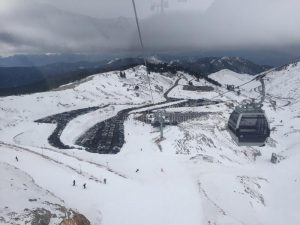

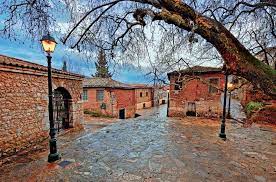
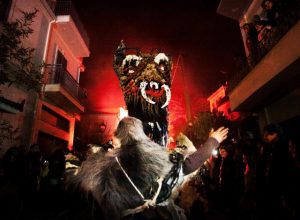
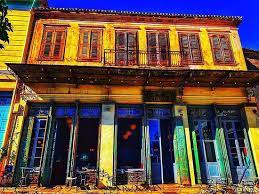
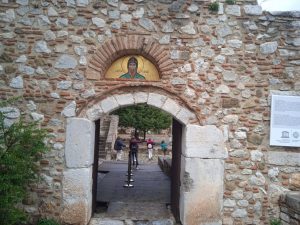
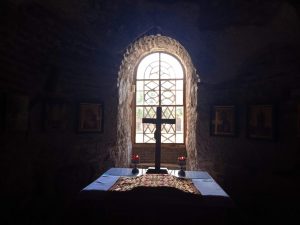
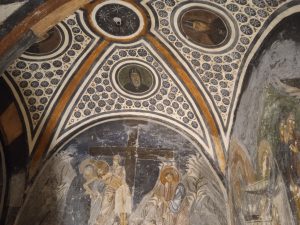
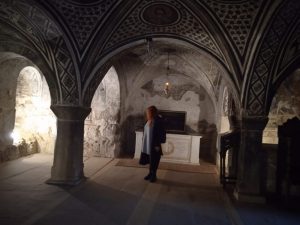
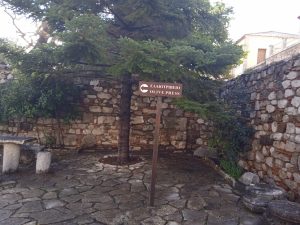
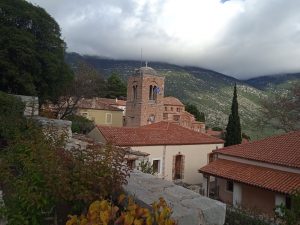
Others
Tab Content
“The Path of Sea and Light”- Skyros Island
Destination
Attractions
Sustainability
How to get here
Accommodation
Food
Impressions
Links
Destination
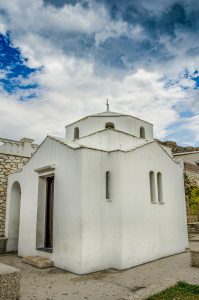 The island of Skyros is located east of Evia. The word Skyros means rubble of stone and as many historians believe, Skyros got its name from “Skyria stone”, the famous Skyros colored marble, with which the Romans decorated their mansions.
The island of Skyros is located east of Evia. The word Skyros means rubble of stone and as many historians believe, Skyros got its name from “Skyria stone”, the famous Skyros colored marble, with which the Romans decorated their mansions.
The island has dense vegetation in the Northeast, while the southeastern part of the island is rocky. «Hora» is the largest settlement on the island.
According to Greek mythology, Neoptolemus, son of Achilles, was from Skyros, as Sophocles mentions in his tragedy “Philoctetes”, Theseus died in Skyros.
Skyros was conquered by the Macedonians, the Romans, the Athenians. In 1538, Jaredin Barbarossa occupied the island and became part of the Ottoman Empire. The inhabitants were forced to take refuge in the famous castle of the island, because they were beset by pirates.
The island offered financial and naval assistance to the Greek revolution of 1821 and later joined the newly formed Greek state.
Attractions
Skyros Town, Kalogria bay and neighboring pine forest, are landscapes of unique beauty on the island. The mountain “Kochilas” has a special natural wealth and for this reason belongs to the European network of areas “Natura 2000” and hosts various rare species of birds.
The castle of the island, which was the ancient Acropolis and the residence of King Lykomidis, became in 1537 a refuge for the inhabitants to protect themselves from pirates. Next to the castle is the monastery of Ag. Georgios, who is also the protector of the island and one of the most important monasteries in Greece. The monastery was founded in 960 AD. century by the emperor Nikiforos Phokas and was renovated in the 16th century.
In the museum “Faltaic”, one can get acquainted with the traditional objects that characterized the daily life of the inhabitants. In the archeological museum, the archeological findings reveal the great history of Skyros.
In Skyros you can admire the Skyrian ponies, whose species is considered as one of the rarest in the world. Today in Greece there are a total of 260 ponies, 187 of them, live in Skyros.
The cobbled streets of Skyros with the whitewashed houses adorned with purple bougainvilleas, capture a genuine image of the Greek summer and the view of the sunset from Brooks Square, is unique.
On the island there are many beaches for swimming. “Magazia” beach is the most popular with fine sand. The quiet beach “Pefkos” has fine pebbles and “Kyra Panagia”, “Pateritsa” and “Theotokos” are the most deserted.
It is worth visiting Skyros during the carnival period and to get to know the customs of the area and to participate in the festive events of the island.
If you want to combine summer vacations with environmental activities, you can participate in the Environmental program “Skyros Project” in the port of Linaria. By completing the program you will acquire skills that promote a responsible environmental behavior.
The wood carving art and the traditional handicrafts of Skyros with their unique style are famous all over Greece. So do not miss the opportunity to get to know the traditional arts of the island.
Sustainability
Skyros is part of the top 100 green destinations of “Green Destination” program, that supports destinations around the world in order to improve the place and way of life, according to the criteria and goals recognized by the United Nations. For this reason, the Municipality of Skyros utilizes the natural wealth of the island in combination with the cultural tradition and intends:
- To utilize the renewable energy sources,in the island.
- To upgrade Skyros high school with renewable energy sources, solar systems, water saving systems and to operate the first bioclimatic gym.
- Skyros High School to be the first green school
- To gradually transform the island of Skyros into an area of sustainable development and is based on the utilization of cultural heritage in combination with natural wealth.
Finally, you can participate in the Skyros Project, which takes place every summer on the island. The Skyros Port Fund cooperates with the Special Academic Unit of Environmental Education, Training and Communication of the University of West Attica in the environmental program. You can participate in the activities of the Academy of Environmental Educators and be trained in the field of Environmental Awareness.
How to get here
You can visit Skyros by plane or ship. There is a daily shipping route that connects Skyros with the port of Kimi in Evia. The journey takes 1 hour and 45 minutes. There is a bus connection from the port of Kimi to Chalkida and Athens.
Skyros also has an airport where there are flights from Athens and Thessaloniki to Skyros as well as air transport services, between Skyros and Vienna.
Ferries to Skyros Island:
https://www.sne.gr/index-en.php
Flights to Skyros Island:
Accommodation
There are many hotels you can stay in Skyros island. However we recommend you“Nefeli” hotel in Chora of Skyros island. The Nefeli hotel is the most environmentally friendly in the island and it combines the modern and the ecological way of living.
Although Nefeli hotel follows a modern recycling program, it has an effective and traditional way of recycling food waste. Leftovers are never thrown away, but they are given to the farm animals. Moreover, the rainwater is collected in cisterns, to water the plants.
The hotel organic farm produces fruits and vegetables and if you choose Nefeli hotel for your accommodation you can taste fresh fruits of the farm in daily basis.
Food
Skyros is famous for its delicious food creations.
If you plan to visit the island, do not miss to taste the traditional cuisine such as, cheese pie, with the traditional “Skyrian” cheese, “Teropitaria” with trachana and rice, spaghetti, “soutzoukakia Skyriana” and local ‘fava” beans.
You should also taste the traditional sweets of the island, such as macaroons, baklava, fruit jams and genuine Skyrian ice cream.
A very special cheese from Skyros. The locals make it, by using cheese from goat’s and sheep’s milk and then they place it for 6 months in a jar filled with thyme and melangi (hard soil that used to be used on the island as a sealant for the terraces and is inserted so that there is no space for insects to enter). It has a dark color and rich taste.
Impressions

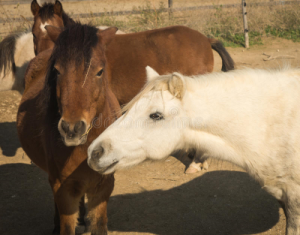
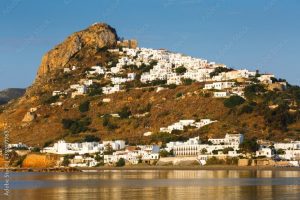
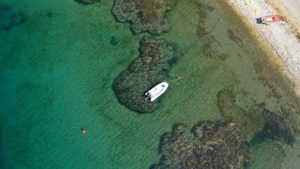
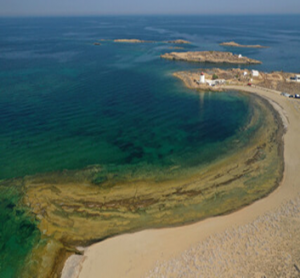
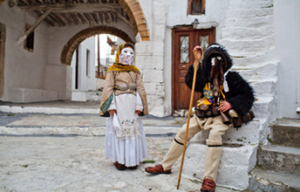
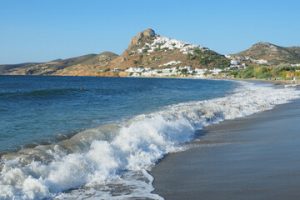
Links
SKYROS ISLAND
CULTURAL AND ENVIRONMENTAL
SUSTAINABILITY VIDEO PRESENTATION OF THE ISLAND OF SKYROS : SKYROS:“THE PATH OF SEA AND LIGHT” VIDEO PRESENTATION OF THE “SKYROS PROJECT”
https://animoto.com/play/18ggfm4YAZNhS8DVd6Nm9w
VIDEO PRESENTATION OF THE “SKYROS PROJECT” ACTIVITIES AND IMPRESSIONS
https://www.youtube.com/watch?v=d57cHC_DBSM
